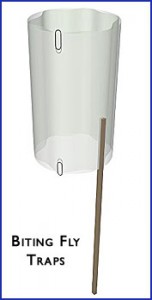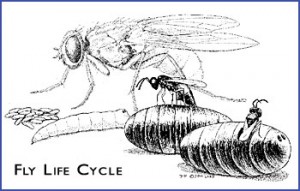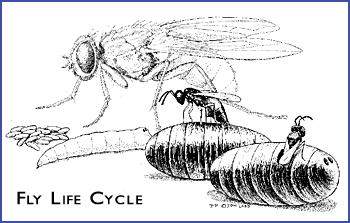Fly Traps for House Flies and Stable Flies
Remember: Anything that you can do to disrupt the fly life cycle will help to keep their numbers down.
Biting Fly Traps
 |
These help control horse flies, deer flies, and horn flies in pastures, paddocks, kennels and swimming pools. Biting flies are attracted to the special fiberglass panel and trapped by replaceable Stiky Sleeve. Each trap can catch as many as 5000 flies.Package Contains: |
|
Fly Parasites For House Flies and Stable Flies
Remember: Anything you can do to disrupt the fly life cycle will help keep their numbers down.
Use of Fly Parasites:
 |
|
They’re a Natural!
Fly parasites prevent adult flies from hatching. These tiny beneficial insects kill the pupae and then use the killed pupae as “nurseries” to grow new parasites.
Stop Fly Breeding with Fly Parasites
Release throughout the fly season every week or every other week. See the recommended release schedules below. Place the Fly Parasites near manure piles, in stalls and areas of the paddock where horses tend to congregate and areas where moisture encourages maggots to appear. Shortly after the maggots form pupae, the Fly Parasites will attack them.
Fly Parasite Schedules (shipping cost included) Order by June 10
(A host pupa contains 1 to 8 fly parasites, depending on the species.)
Arrives between Wednesday and Friday.
| Sched. | No. of Horses | No. of host pupae | No. of shipments | Frequency | Total Charge |
| A | 1 – 9 | 5,000 | 10 | Every other week | $ 228.85 |
| B | 10 – 19 | 10,000 | 10 | Every other week | $ 278.98 |
| C | 20 – 39 | 10,000 | 20 | Weekly | $ 519.20 |
For best results, start in May.
IPM Laboratories, Inc. warrants that the biological controls you receive will be alive and healthy when received and will contain the correct number of the species you ordered. However, as with any pest control measure, success cannot be guaranteed. IPM Laboratories, Inc. makes no guarantee, express or implied, as to the effectiveness of these products.
Control of Manure Flies & Biting Flies in Stables/Pastures
Horse owners have three fly control problems: manure flies in stables, biting flies around paddocks and pastures, and face flies. IPM Laboratories offers product solutions for the first two vexing problems and advice on non-toxic control of face flies.
Use of Fly Parasites:

|
|
| They’re a Natural!Fly parasites prevent adult flies from hatching. These tiny beneficial insects kill the pupae and then use the killed pupae as “nurseries” to grow new parasites. |
Stop Fly Breeding with Fly Parasites
Fly parasites kill flies in the pupa stage before they hatch into flies. These are tiny wasps (the size of a fruit fly) that specialize in killing flies. They do not sting people or mammals. These beneficial are naturally occurring and widespread in low numbers. They just need reinforcement to exert fly control where fly breeding is abundant.
Trap Flies in the Stable, Trap Biting Flies Outside
Flies in the stable come from two sources: breeding on the farm and breeding off the farm. Use giant sticky traps to trap those flies that come in from elsewhere or escape consumption by their natural enemies.
Biting flies breed in wetlands. They are strong fliers and can move long distances. Effective control involves trapping them as they move to your farm. We offer Biting Fly Traps for biting flies outdoors around paddocks.
Face Flies
Face flies breed in the pasture and elude most forms of control. They also can travel long distances from other pastures. One of the easiest and most effective non-toxic solutions is the fly mask.
IPM Laboratories, Inc. warrants that the biological controls you receive will be alive and healthy when received and will contain the correct number of the species you ordered. However, as with any pest control measure, success cannot be guaranteed. IPM Laboratories, Inc. makes no guarantee, express or implied, as to the effectiveness of these products.
Take a look at the Guardian Plant container that I entered into the Kathy Pufahl mixed planter competition at the Cornell Floriculture Field Days. The first place medal is in the Home Gardener class. The plants in the container include barley for an aphid banker plant, marigolds for thrips control, Garten Mister fuschia for whitefly control, lantana for whitefly control, and black pearl ornamental pepper for thrips control.
Fly parasites are natural inhabitants of cattle manure. However, their numbers are reduced to zero with manure cleanouts or after the use of strong pesticides. Without help, fly parasite numbers rebuild slowly. The major fly outbreaks that occur after cleanouts in poultry barns demonstrate the massive effect that natural enemies normally exert on fly populations.
Fly parasites prevent adult flies from hatching. These tiny beneficial insects kill fly pupae and then use the killed pupae as “nurseries” to grow new parasites. Fly parasites are tiny insects in the wasp family that live only to search out, kill, and lay eggs in fly pupae. They move about unnoticed because of their small size.

The illustration shows the stages of the fly life cycle. The fly adult, fly eggs and maggots are light grey in the background. The fly pupae are black and each has a fly parasite on it. The fly parasite to the left is a mature adult female that is preparing to sting and kill the pupa. It may also lay an egg inside the pupa that will mature into a new fly parasite. The fly parasite on the right is a new adult that has just chewed its way out of the host pupa.
Quality Assured: IPM Laboratories Fly Parasites come in units of 10,000 host pupae called colonies. Host pupae are inspected prior to shipment to assure that they carry fly parasites. Some pupae that have been killed by fly parasite attack do not carry new fly parasites. These empty pupae are not counted as host pupae.
FLY PARASITES SPECIES MIX: IPM Laboratories varies the mixture of species with the time of year: Muscidifurax raptor for the cold winter months. During the warmer seasons, we add Muscidifurax raptorellus. M. raptorellus produces multiple offspring per host pupa. M. raptor produces a single offspring in each host pupa. Nasonia vitripennis, a commonly available fly parasite, is not recommended for dairies since it has not been recovered from dairy barns.
Plan your fly control program in the spring. Call us and set up an IPM Laboratories Fly Parasite introduction program to kill fly pupae. Introduce fly parasites weekly or biweekly throughout the fly season, approximately May 15 through October 1 in the Northeastern United States.
Tipping the balance to favor the natural enemies and reduce the fly population requires an integrated approach that includes weekly removal of manure and other fly breeding sites, use of fly bait and sticky traps, release of parasitic wasps, and avoidance of residual insecticides. Residual sprays will continue to kill fly parasites for several weeks after they have stopped killing flies.
Release Parasitic Wasps in Fly Breeding Areas
Release parasitic wasps in fly breeding areas. A fly breeding area is usually moist organic matter which attracts flies to lay eggs and then supports the growth and maturation of fly maggots. Favorite breeding areas for flies include calf hutches, wet spilled feed, and moist manure and bedding (particularly straw). Under optimum conditions, with no natural enemies, 2 square feet of moist organic material can generate 10,000 flies in two weeks. Release fly parasites in the drier areas directly adjacent to breeding areas to kill the fly pupae before they turn into adult flies. Application rates are listed on the chart below. Scatter the package contents next to the fly breeding sites, or in nearby corners where they
will not be crushed, buried, or disturbed for several days.
| Site | No. Host Pupae | Unit |
| Calf Hutches | 500-1000 | per hutch |
| Bedded Pack | 250 | per animal |
| Cleaned Areas 1 | 5000-10,000 | per barn or site |
| Wet Edges 2 | 25-100 | per sq. foot |
1 see text under Manure Management
2 see text under Other Breeding Sites
Equivalencies (volumetric, liquid measure):
| Number of host pupae | How to measure |
| 500 1/20 colony | 3 Tablespoons |
| 1000 1/10 colony | 3 ounce cup, or 6 Tablespoons |
| 2500 ¼ colony | 1 cup |
| 5000 ½ colony | 2 cups |
| 10,000 1 colony | 4 cups |
MANURE MANAGEMENT: In the summer, the fly life-cycle takes about two weeks: one week for the larvae to develop and one week to pupate before emerging as new adults. Weekly removal and spreading of manure disrupts the fly life-cycle, preventing new adults from emerging in and around the barn. Removing the manure also helps the parasitic wasps, which find fly pupae more easily if the depth of the manure is relatively shallow.
Cleaned Areas: Areas that are cleaned daily or weekly need a minimum number of parasites to patrol the corners and pockets of manure.
Moisture control through good drainage and aeration, will reduce the number of eggs that each fly lays, thereby requiring fewer fly parasites for the same area.
OTHER BREEDING SITES: Calf bedding and wet edges. Any accumulation of wet feed or bedding is a potential fly breeding site if it is allowed to accumulate for more than a week. Calf bedding may be the most important site to place fly parasites. It is important to place fly parasites inside calf hutches because it is unlikely that they will find the front entrance of the hutch quickly enough to kill the first generation of fly pupae.
Wet areas around water troughs and moist areas along the edges of spilled feed or manure piles are also prime sites for growing fly maggots.
Traps. Sticky paper, tapes, or ribbons and bait traps will help reduce the adults fly population without hurting the natural enemies.
Insecticides. Baits do not harm the parasites. For space sprays, recent studies conducted by Cornell University on three 50-70 cow dairy farms demonstrated that weekly releases of 25,000 fly parasites, combined with good manure management reduced fly numbers by more than half during peak season between mid-July and mid-August. Non-residual space sprays with synergized pyrethrins were used by two of the farmers to keep fly numbers below their personal tolerance. Sprays should be timed a couple of days before or after a parasite release. These non-residual insecticides are not as hard on the fly parasites as residual sprays, which will do more harm to the parasites than to the flies.
Using Hister BeetlesHISTER HOUSE™ Hister Beetle TrapUnited States Patent Number 5,930,945
JUST ADD WATER– The Hister House™ is constructed to attract Hister Beetles and exclude litter beetles. The trap is a small box filled with bait that is activated by adding water. The beetles enter the trap through a screen that has openings that are too small for the litter beetle to push through but large enough for the Hister Beetle.
USE 100 TO 300 HISTER HOUSES™ per manure pit. These should trap 200 to 600 or more beetles
per trap, yielding 20,000 to 180,000 or more beetles for transfer.
CATCHES CAN AVERAGE 600 BEETLES PER TRAP where beetles are numerous. Up to 2000 hister
beetles have been caught in the Hister House™ over a 24 hour period. Traps will catch less
than a hundred beetles each in manure where there are few beetles. We recommend that traps
not be used when there are less than 20 beetles per square foot.
TRAP AND STORE Collect beetles from manure accumulations prior to clean-out, and store
the beetles until a new manure pile has started to accumulate. Beetles will not be harmed by
two weeks of storage at 50° F. Mortality will be obvious at 10 weeks.
The Hister House was initially developed under USDA SBIR award #95-33610-1487
LAB-REARED ADULT HISTER BEETLES
HISTER BEETLES FOR CLEAN CONDITIONS
Where beetles from another building or another manure are not desirable, lab-reared beetles
are produced in an environment with no birds. IPM Laboratories’ beetle colony is
periodically tested for evidence of Salmonella, and remains Salmonella-negative.
TEN THOUSAND BEETLES PER PIT
An inoculation of 10,000 hister beetles is an effective way to assure colonization of the
manure with hister beetles. Release beetles in small clumps onto every manure pile, as they
do not travel easily between piles.
RELEASE INTO MANURE AT LEAST 3 WEEKS OLD
The beetles need habitat that has both dryness, moisture and food. Do not release into wet
sites.
BEETLES ARE WELL-FED AND READY TO LAY EGGS
The beetle larvae that hatch from these eggs will start consuming fly eggs immediately. The
second generation of adult beetles will be begin to be evident 4 to 6 weeks after initial
beetle introduction at 80°F. The beetle populations will grow very slowly at 60° F.
™ Hister House is a trademark owned by IPM Laboratories, Inc.
Using Hister BeetlesHister Beetles Prevent Fly Outbreaks in Long-Term Poultry Manure Accumulations
Fly control is excellent in manure packs that have high numbers of Hister Beetles. We have observed beetle densities as high as 250 beetles per quart of manure and 12 beetles per square inch of manure. Houses that have been completely cleaned out and disinfected often need to be recolonized with Hister Beetles.

Use of Hister Beetles
The beetles are so tiny that 250 can fit in a milliliter.
They should not be confused with the much larger litter beetles (which are the same as darkling beetles and lesser mealworms). Litter beetles are brown and more than ¼ inch long. Litter beetles destroy insulation and structures. Hister beetles do NOT harm insulation or structures.
Hister beetles are shiny black beetles that are slightly longer than 1/16 inch. When you normally see them, they will have their legs and head tucked in under their bodies. The beetle in the illustration is crawling with a fly egg in its mandibles.
Pest Management
THE HISTER EFFECT: The Hister Beetle consumes large numbers of house fly eggs and small housefly larvae in poultry manure. Each adult destroys an average of 54 housefly immatures per day at 80° F. Hister larvae are also predaceous and highly aggressive.
Since Hister Beetles attack the early fly stages, your biological control program should include fly parasites to attack the flies that make it to the pupal stage.
Program Planning
Plan your next fly control program prior to cleanout. Call your beneficial insect supplier and set up a Fly Parasite introduction program to kill
fly pupae AND Order Hister House™ beetle traps to collect and store home-grown beetles from manure prior
to clean-out OR Order laboratory-reared Hister Beetle Adults to introduce into three week old manure.
IPM Laboratories, Inc. makes no guarantee, express or implied, as to the
effectiveness of these products.
All images are copyrighted to IPM
Laboratories, Inc. and may not be copied or reproduced without
permission.